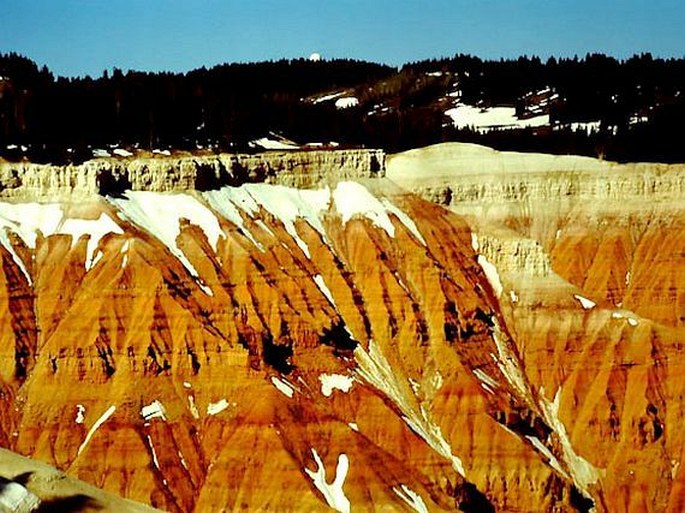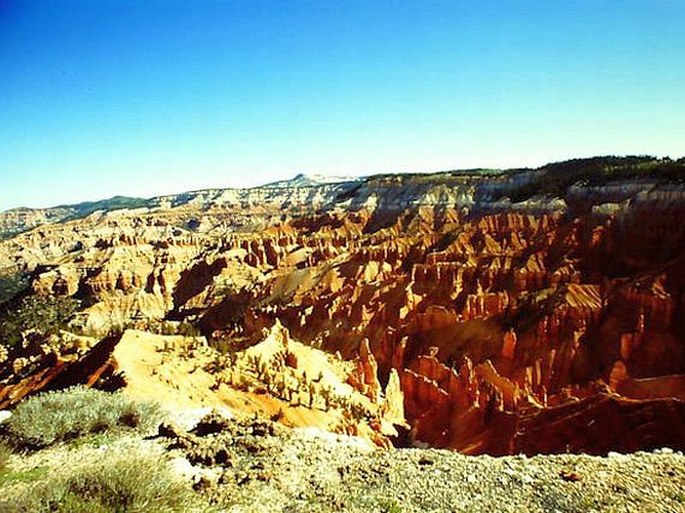Cedar Breaks National Monument is located in vicinity of Zion and Bryce Canyon National Parks in southern Utah. If you era visiting one of these parks it is just a short excursion to go to this unique high elevation park.

It is a natural amphitheater almost 5 km wide and over 600 m deep of eroded colourful rock. The rocks are mostly sedimentary limestone in various colour shades of red and orange from oxidized iron and purple hues from manganese. These sediments date back 60 million years and present elevation over 3000 m is due to uplift by faulting at about 10 million years ago. This Hurricane Fault is still active. The amphitheater is the headwaters of Mammoth Creek, a tributary of Sevier River.
The park is open from June but it is possible that even in July you are surrounded by snow. The name comes from early settlers of this region because they imagined that the cedars grow in these mountains and „breaks“ is a local expression for badlands. Indians called it the Circle of Painted Cliffs. This park called monument was established in 1933.

The high mountain fauna and flora can be seen here. The pikas (Ochotona princeps) are very common here, Yellow-bellied marmots (Marmota flaviventris), badger, bobcat, mountain lion and many more. The cliff crevices are ideal nesting habitat for Violet-green Swallows (Tachycineta thalassina), Clark’s Nutcracker (Nucifraga columbiana) feed on conifer seeds, even two species of hummingbird can be seen at this elevation and short summer season.

At the mountain tops you can find Bristlecone Pine (Pinus longaeva), the longest living organism on earth. The forests consist mostly of high elevation Engelmann’s Spruce (Picea engelmannii), Douglas Fir (Pseudotsuga menziesii) and Subalpine Fir (Abies lasiocarpa). As wildflowers are concerned, it is a collection of Rocky Mountain plants which includes a couple of Beardtongues (Penstemon spp.), Yellow Evening Primrose (Oenothera flava), Panguitch Buckwheat (Eriogonum panguicense), Green Gentian (Frasera speciosa) and more and more (listed below).

The sampler of plant species found in the park:
Abies lasiocarpa – Subalpine Fir
Aconitum columbianum – Monkshood
Aquilegia caerulea – Colorado Columbine
Arnica cordifolia – Heartleaf Arnica
Caltha leptosepala – Marsh Marigold
Cardamine cordifolia – Heart Bittercress
Castilleja parvula – Scarlet Paintbrush
Delphinium occidentale – Subalpine Larkspur
Dodecatheon pulchellum – Shooting Star
Epilobium angustifolium – Rosebay Willowherb
Eriogonum panguicense – Panguitch Buckwheat
Eriogonum umbellatum – Sulphur Buckwheat
Frasera speciosa – Elkweed
Gentianopsis detonsa – Meadow Gentian
Geranium richardsonii – Richard Geranium
Geum triflorum – Prairie Smoke
Helianthella uniflora – Little Sunflower
Hymenoxys hoopesii – Orange Sneezeweed
Ipomopsis tridactyla – Cedar Breaks Gilia
Ligusticum porteri – Southern Ligusticum
Linum lewisii – Blue Flax
Lupinus argenteus – Silvery Lupine
Mertensia arizonica – Aspen Bluebells
Oenothera flava – Yellow Evening Primrose
Pedicularis groenlandica – Elephanthead
Penstemon leiophyllus – Markagunt Penstemon
Penstemon rydbergii – Rydberg Penstemon
Phlox pulvinata – Cushion Phlox
Picea engelmannii – Englemann Spruce
Pinus flexilis – Limber Pine
Pinus longaeva – Bristlecone Pine
Polygonum bistortoides – American Bistort
Potentilla fruticosa – Shrubby Cinquefoil
Primula parryi – Parry Primrose
Pseudotsuga menziesii – Douglas-Fir
Ranunculus alismifolius – Plantain Leafbutter
Sambucus racemosa – Red Elderberry
Viguiera multiflora – Showy Goldeneye
Zigadenus elegans – Mountain Deathcamas

These images were taken in 1995.


